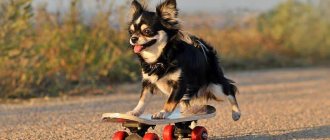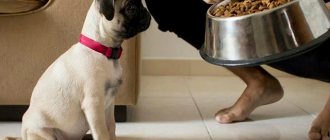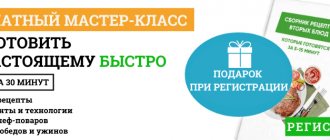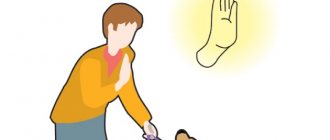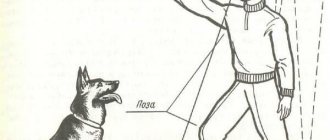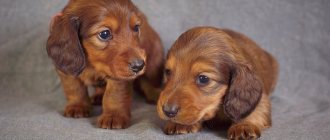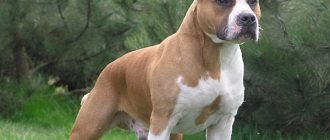The Toy Terrier is a dog that is ideal for keeping both in an apartment and in a private house, both in the city and outside the city.
The dog is friendly, sociable, and easy to get along with. This is a wonderful friend and a cute pet.
But this breed also has disadvantages - fragility, miniature size and weak immunity.
This is what makes him so vulnerable.
Toy often gets injured and cannot tolerate cold and dampness.
At what age should training begin?
Usually, training a toy terrier puppy at home begins at one month of age, but if the baby arrived in the house later, training can begin at 2 or 3 months .
Start learning with the basic rules that are accepted in your family. The dog must know its place, be accustomed to the litter tray, recognize the authority of the owner, etc.
After six months, you should take training more seriously and start teaching your baby commands . At this point, he must be sufficiently well-mannered and obedient.
Cost of training with a dog handler
Dog trainers know best how to train a Yorkshire Terrier. You should contact a specialist if the owner is a novice dog breeder and has no experience raising dogs. Sometimes the help of a specialist is required if the dog has developed bad habits. The specialist will teach you how to interact correctly with your Yorkie and gain his trust.
He will tell you what to pay attention to, what to allow and what to prohibit, and how to punish. Group and individual lessons with a dog handler allow you to ensure that your pet unquestioningly follows commands regardless of environmental conditions
The cost of classes depends on the complexity of the training and the reputation of the dog handler. A general training course will cost 1600-1800 rubles per session. The entire course costs 7,000-15,000 rubles. When correcting unwanted behavior, training will cost more - 2,500 rubles per session.
Despite its small size, the Yorkshire Terrier is an active, intelligent dog. Raising and training such a pet does not cause problems, but requires patience and perseverance. Yorkies are inquisitive, energetic, and eager to please their owner. If you don't make mistakes, communicating with such a dog will bring pleasure to everyone.
YORKSHIRE TERRIER: DESCRIPTION OF THE BREED, STANDARDS, HOW LONG DO YORKIES LIVE
Yorkshire Terrier: description of the breed according to the standard, character and developmental characteristics of dogs, life expectancy, advantages and...
IS IT ALLERGY TO YORKSHIRE TERRIERS?
Many breeders believe that the Yorkshire Terrier is a hypoallergenic dog that can be safely owned by a person…
NICKNAMES FOR YORKSHIRE BOYS AND GIRLS - WHAT TO NAME A YORKSHIRE TERRIER
Popular nicknames for Yorkie boys and girls by temperament, origin, pedigree, color, what are the names of Yorkies...
COMBES FOR YORKIES. WHICH ONE TO CHOOSE?
It's time to figure out what combs for Yorkies you need to have. Success in grooming on...
TRAINING AND TEACHING THE YORKSHIRE TERRIER AT HOME
Training a Yorkie is not difficult. The main thing is to be consistent, follow the recommendations of dog handlers and avoid common...
CREATIVE HAIRCUT FOR YORKSHIRE TERRIERS
The most popular creative Yorkie haircut, ideal for babyfaces. This sweet and naive face is at its peak...
CLOTHING FOR YORKIES: BUY OR MAKE YOUR OWN HANDS
Yorkshire Terrier is a decorative breed. These dogs are thermophilic, and since they live all year round in…
HOW TO TRAIN A YORKSHIRE TERRIER TO NAPPY
Diaper training a Yorkshire Terrier is very helpful for people with busy daily routines, so as not to...
WHAT TO DO IF YOUR YORKIE'S EYES ARE TEARING
What to do if your Yorkie's eyes are watery: Causes and prevention
YORKSHIRE TERRIER - HISTORY OF THE BREED
Today the Yorkshire Terrier is one of the most popular and famous dog breeds, but few people think about…
STERILIZATION OF A YORKIE: IS IT WORTH CARRYING OUT FOR A BOY AND A GIRL
Castration of a Yorkie – is it worth doing, the pros and cons of the procedure. Sterilization of a Yorkie, features, when you can...
PREGNANCY AND BIRTH IN THE YORKSHIRE TERRIER
The course of pregnancy and childbirth in a Yorkshire terrier, the owner’s assistance in the birth process, rules of care and...
What should a dog be able to do?
Minimum required:
- The puppy must know its place. To do this, under no circumstances should you take him to the bed.
- A well-mannered pet always knows a place to relieve itself.
- The dog should not chew things on shoes.
- Know basic commands and execute them.
- Respect the authority of the owner.
- A toy terrier must know his name and respond to it.
- A well-mannered dog treats people calmly, does not bark, does not bite, or behaves aggressively.
- A properly trained toy is comfortable with a leash and collar.
Raising a Toy Terrier is different from raising a large service dog . There is no question of physical punishment or raising one's voice here. Otherwise, the dog may get scared or even run away.
Maintenance, care
The compact toy feels good both in a small city apartment and in a large country house with a plot.
He should only live indoors. The breed is undemanding in terms of grooming - long-haired individuals are periodically brushed and bathed once every 3-4 months. Short-haired dogs can simply be dried with a wet towel even after a walk in dirty weather. The peculiarity of the conditions of detention is to protect the baby from accidents. It is easy to miss him and crush him under the door; he can crawl into a tight gap from where he cannot get out on his own. It is better to limit the area where he will be. Basic care comes down to walking. You can teach your baby to do his business in the diaper. But small terriers need to run to release pent-up energy. Teach your pet the “fetch” command, and he will satisfy his needs for movement. A walk combined with running will have a positive effect on his health and obedience.
There are no difficulties with feeding either. Choose the option that is most convenient for you - dry food or natural food. The diet should be balanced. Mixed food is not recommended for toy terriers.
Where to start education?
You should start raising a toy terrier by teaching the basic rules, namely:
- Accustoming to cleanliness. The dog must strictly know the place where it should go to the toilet. This could be a litter tray or a diaper.
- Be sure to show the dog his place, this could be a pillow in a cozy place, an old mattress or a special house. Under no circumstances should your dog sleep with you.
- Stop any attempt at aggressive behavior. If the dog tries to bite, let him know who is in charge.
- Teach your baby to hygiene procedures - trimming nails, combing and cutting. The latter is especially important for long-haired toys.
- A Toy puppy should tolerate loneliness calmly. Get him used to this gradually. Leave the lady alone for 15-20 minutes. Then increase the time.
- A little later, accustom your dog to a leash.
Expert opinion
Kozhevin Semyon Kirillovich
Expert dog handler.
The toy terrier is a choleric dog, sometimes it is characterized by aggression and violent expression of feelings, it develops reflex connections very quickly and also quickly fades away. Once you have achieved excellent command performance, do not give up on your studies. This requires a special approach. Regularity, consistency, loyalty - these are the keys to good upbringing.
Breed characteristics
Due to their appearance, German Jagdterriers are often confused with pinschers, small Dobermanns, and miniature pinschers. This problem is associated with the black and tan coat color of the animal. A striking difference between Yagds and these breeds is the manifestation of hunting, rather than guarding qualities. The difference can also be found in the body structure of the animal. Developed muscles, strong bones, dense but elastic skin - these are the main features of the German Hunting Terrier.
International Canine Organization standard
This is a small compact dog. The physique is proportional, square type. An important condition in the standard is that the chest circumference exceeds the height at the withers by 10-12 cm. The animal's tail is traditionally docked, leaving only 2/3 of the length. This is done for ease of grip when pulling the dog out of the hole. The standard also defines other characteristics of the German Hunting Terrier:
- The head is wedge-shaped, flattened between the ears, the cheekbones are slightly defined, the cheeks are flat.
- The muzzle is strong and powerful, tapering smoothly from the tip of the nose, which in most cases is black.
- The lips have a black border and fit tightly. The jaws are well developed and strong. The teeth are large with a scissor bite.
- The ears are triangular, small, set high, hanging on cartilaginous tissue.
- The eyes are oval-shaped, deep-set, the iris is dark brown, the eyelids are dry and dense.
- The neck is of medium length, has a pronounced scruff and well-developed muscles. It transitions smoothly into a pronounced withers.
- Limbs. The front ones are parallel and are distinguished by strong bones and lean muscles. The hind limbs are set more widely apart and have pronounced knee joints.
Coat type and color
According to the breed description, the coat of the German Jagd Terrier can be hard or smooth. Regardless of its type, the color is standardized. The main color can only be black, dark brown or black and silver. The Jagdterrier breed has some color features:
- light tan markings are required on the head, muzzle, sides, belly, chest and lower legs;
- white spots are not considered a disqualifying sign only on the chest and fingers;
- Markings near the eyes in the form of a mask are allowed.
Purpose of the German Terrier
Initially, the Jagdterrier dog breed was bred for hunting. The animal was obliged to help the hunter when catching the animal from the hole. These include:
- badgers;
- foxes;
- raccoons.
A good hunting result can be obtained if you use a yagda together with another representative of this breed or a dachshund. They can drive down not only a burrowing animal, but also a larger one, for example, a wild boar. Today, the hardy German Terrier is often used as a common gun dog for hunting foxes and hares and serving shot game. The pet is able to destroy rats, mice and moles. For this reason, the German Terrier is a multi-purpose animal. It is often kept as a pet.
How to teach behavior on the street?
Even if your pet is no longer a puppy, it is quite possible and even necessary to accustom him to the street.
Observe your toy on the street: is he afraid, how does he treat people and other animals, how does he react to noise, etc..
If the dog is afraid, try to convince him that the street is safe and he is not in danger. Talk to him, stay close to him all the time.
At first, walk with him only when he is in a good mood, when he is cheerful and inclined to play.
If the dog panics, calm it down and go home.
Useful video
From the video you will learn how to train a toy terrier:
Rate the author's article:
1 ratings, average: 5.00 out of 5
Loading…
The Toy Terrier is not the dog that will search for drugs at airports, catch violators at the border, or detain a criminal along with the police. However, this does not mean that the terrier does not need education and training.
The most interesting thing is that if training a terrier is necessary in order for it to obey, then education should be mutual - for the animal itself and its owner.
How to stop barking and biting?
First of all, you should find out the reasons for this behavior.
There are only two of them:
- Playfulness.
- Dominance.
In the first case, the dog does not bite on purpose, during play.
Just stop playing if the baby is too carried away and strictly say “no” . It would be enough.
If the reason is dominance, this means that the dog considers himself in charge. Be firm, behave confidently, apply sanctions and do not allow your pet unnecessary things.
As punishment, you can deprive your pet of games, treats, or ignore.
How to teach basic commands?
Basic commands include those that are based on the basic instincts of the animal and are the easiest to learn.:
- "Ugh" . command, control is recommended to be taught first. It is given when a pet does something inappropriate. During the training process, make it clear what the dog should not do.
- "Place" . Also the bottom of the most important teams. Show your baby the place where he should sleep, while clearly pronouncing the “Place” command. Remember - the command must be pronounced in a firm and firm voice. If your dog complies, reward him with a treat.
- "To me" . This command trains the pet to approach the owner upon request. Start learning at home. To do this, say the dog’s name loudly and command “Come to me.” If the dog obeys, give him a treat.
- . " This command is not particularly important, but it is still worth teaching your pet to it.
Excessive training
Adequate load during training is of great importance! Some owners believe that because their dogs can run around the park for hours, they have enough energy for a 3-5 hour workout. Sometimes dog owners simply find this schedule convenient – there is no time for a pet on weekdays, but on weekends we can make up for it! However, we must not forget that the positive result of training directly depends on the dog’s interest. What dog likes to perform the same actions for several hours in a row? Be smart and don't overload your pet. One lesson with an adult animal should last a maximum of two hours (with rest breaks). You can exercise with a small puppy for only 5-10 minutes (2-3 times a day if desired).
Toy Terrier training by month
1-3 months
At this age, the puppy is taught basic rules of behavior, this:
- Sleep peacefully at night, don’t whine and don’t ask to go to bed with your owner. Here you will have to show firmness and willpower.
- Toilet training. This could be a tray or a cloth. To make it easier for your dog to get used to it, place the tray where she most often relieves herself. Show your baby that he needs to “do his business” in the tray. When your pet gets used to it, gradually move the tray towards the place where he will stand
- Accustoming the puppy to its place. To do this, first introduce the dog to his “bed”. Firmly say “Place” and take the puppy there. Do this several times. Then stand near the dog’s place, say its name and command “Place”; if the baby obeys, give it a treat.
- Teach your puppy not to jump on furniture or damage things.
4 to 6 months
At this age, they begin to accustom the toy to unfamiliar places, as well as to a leash and collar. At first, do this at home. Put a collar on your puppy and let him walk around the house in it.
Repeat this action for several days, this will allow the puppy to get used to it . Now you can attach the leash and show the dog what it is for.
6-8 months
Now it's time to learn the basic commands.
These are commands such as: “Fu”, “You can’t”, “Place”, “Walk”, etc..
Of course, the baby will have to learn some of them much earlier. At this age, the owner should pay maximum attention to training the dog.
Commands must be executed clearly and quickly . If you have any difficulties, contact a professional dog handler. A specialist will help teach the toy terrier commands and also give the necessary recommendations.
It is worth considering that at this age the dog begins puberty - girls experience their first heat, and male dogs begin to react to females in heat. This greatly affects the pet’s behavior, the dog becomes less obedient. The solution to this problem, if breeding work is not planned in the future, can be sterilization.
9 months
During this period, command training continues and the range expands. At this age, the dog must clearly respond to those commands that have already been learned .
If this does not happen, then the training was not of sufficient quality. Persevere in your studies and be consistent.
What else should a dog be able to do at this age?:
- Do not jump on you, passers-by or other pets.
- Know how to behave in elevators and public transport.
- Don't bark for no reason.
- Be calm about the leash and collar.
- Calmly withstand procedures in grooming salons.
10-12 months
At this age, the toy terrier already knows commands and diligently follows them. Now is the time to teach him off-leash walks and appropriate commands.
These are “Near”, “Sit”, “Stand”, “To me” . Walk your dog in quiet, calm places away from the roadway.
Parks, squares, suburban areas are the best option for such a plot.
Feeding
It is recommended to feed a puppy aged 1.5–2 months 6 times a day, alternating cottage cheese diluted with kefir or milk, finely chopped raw meat and milk porridge. To cook porridge, you need to grind rolled oats, rice or buckwheat in a coffee grinder, boil well, adding 1-3 grains of salt. The break between feedings during the day should be 3-4 hours, and at night you need to teach the puppy not to eat for 8 hours.
By 2–3 months, you need to gradually increase portions and reduce the amount of feeding to 5 times a day. Sometimes, instead of milk porridge, you can give porridge with meat. It is also necessary to introduce boiled egg yolk into your pet’s diet.
At 3–5 months, the menu should be expanded to include stewed vegetables and fish. Also, the baby can happily drink his food with cow's milk. At this age, it is enough to feed the puppy 4 times a day.
From 5 to 9 months it is worth switching toy to three meals a day. And after 9 months, the puppy, like an adult dog, eats 2 times a day. There is no longer a need for milk, but do not neglect cottage cheese and fermented milk products, they are necessary at any age.
Even an adult dog should not be given the following foods: sweets, pasta, white bread. A threat to your pet's liver is fatty, smoked and spicy foods, sour cream and butter. As a replacement, you can offer your pet fruit, and occasionally honey or dried black bread.
How to train correctly?
It should be noted that training is a mutual necessity for both the dog and its owner.
How to properly train a toy terrier:
- If you are toilet training your dog, do it gently, tactfully and gradually. The second rule is to do this as early as possible, literally from the first day the baby arrives in your home. Let your pet develop a conditioned reflex - go to the right place - get a reward.
- When you accustom a toy to his place, be sure to be firm. At first, the puppy will whine and ask to go to your bed. This is when you will need willpower. If you make concessions, you will lose your authority.
- Strictly prohibit your puppy from damaging furniture, shoes and objects. Be consistent - scold him every time he tries to chew something. If you use sanitization only from time to time, the puppy will not learn the lesson, he simply will not understand what is required of him.
- Patiently accustom your dog to a leash and collar, this is necessary for his safety. Give your baby a chance to get used to the equipment. Don't insist or force.
- Learning the "Place" command. Show the puppy his place, take him there. Tell him kindly that this place evokes only positive emotions and pleasant sensations. Repeat this process only as many times as necessary.
- Team "Fu". If the puppy does a prohibited action, such as picking up scraps on the street, say loudly “Ugh” and gently remove the dog. The key point is your intonation. Let your pet know exactly what you don’t like.
- Command "Come to me" When your baby voluntarily runs towards you, say loudly “come” and give him a small piece of treat. Do this until the dog understands the connection between the treat, your words and your actions.
- Help your dog socialize. She must treat the people and animals around her calmly. This will be very useful when visiting the veterinarian, when visiting grooming salons, as well as during mating and childbirth. Expand your pet's horizons, visit shops, zoos, dog parks in the same place as him, take your baby with you on a visit, and go for a walk more often.
Puppy training - basic behavior
The principles are laid down when training a toy terrier at home, how to behave.
Behavior on the street
When leaving home, the baby is exposed to new temptations and dangers. To avoid trouble, teach your puppy the following rules:
- When approaching the roadway, stop and say: “Stop, road!” When crossing, order: “Near!”
- Try to avoid the company of ill-mannered dogs. The imitation reflex greatly influences a puppy's learning.
- To avoid the temptation to pick up something from the ground, take household toys for a walk.
- After releasing the dog from the leash, call him with his nickname and the command “Come to me!” Change location, call again. The dog should be looking for you, not the other way around.
- Help the animal adapt to the people and animals around it. This will help in the future during mating, childbirth, visits to the veterinarian, exhibitions, grooming salons.
We teach you to stop barking and biting
It is useful to fuss and play wrestling with the puppy. But if the dog starts playing and starts barking and really biting, stop the activity. The owner's body is inviolable!
How to train your Russian Terrier to understand that you cannot bark and bite:
- Scream quietly and show that you are in pain. The dog does not want to harm you and will understand that this is not the right thing to do.
- If you get bitten again, just get up and leave the room. The dog will be surprised, but will soon realize that he behaved badly.
- The pet may not understand the words, but it picks up the intonation unmistakably. It is enough to portray a dissatisfied tone to stop his pranks.
Tray training
Place the tray in the place where your dog likes to relieve himself. After active play, 10 minutes after eating or sleeping, take the toy to the tray. If he makes a puddle on the floor, blot it with a cloth and place it on the bottom of the container so that the smell remains there.
Sit next to him and pet him. Praise if you did “your job.” Move the tray little by little in the direction where it will be placed.
Advice . Limit the space while training your dog to one room. The training process will then go faster.
Accustoming to hygiene procedures
Hygiene is an integral part of keeping terriers, which also requires training. From an early age, it is necessary to accustom the little toy to the following procedures:
- cleaning the ears with a cotton pad with special products;
- wiping discharge from the eyes;
- teeth cleaning;
- shortening of claws;
- combing;
- bathing.
With regular care, the dog calmly accepts all of the above activities.
Weaning off aggression towards people and animals
There is nothing easier than training a toy terrier puppy to have a balanced attitude towards his environment at an early age. The main thing is not to miss the beginning of a bad habit:
- do not let the puppy bark at guests who come to the house;
- communicate with well-mannered animals, avoid possible clashes;
- Contact a dog handler if the situation gets out of control.
Once developed aggression in a dog is difficult to correct on your own. An experienced trainer will skillfully cope with the difficulty of character.
Basic rules of training
When training your Toy Terrier, strictly follow the following rules::
- Under no circumstances should you yell at the dog, call it names, or raise your voice.
- In the first six months of a puppy’s life, training should be loyal and gentle.
- Firmly stop any aggression.
- Patiently show the dog what is required of it, and be consistent when teaching commands.
- Be sure to reward your dog with treats.
- As a punishment, it is best to choose deprivation of your attention and lack of games.
- Do not hit the dog under any circumstances!
Dog rewards, treats for training
A reward is the key to a successful lesson. A special treat for training a Black Russian Terrier can be either a store-bought product or a home-made one. For example:
- drops;
- chewing sticks;
- dog biscuits;
- meat crackers;
- pieces of dried bread.
But use rewards wisely; do not constantly give your dog “treats” throughout the training. Reward your dog while learning a new command. And when it has already been learned, praise will be enough.
Important! Generous rewards reduce their value and reduce the zeal for obedience.
